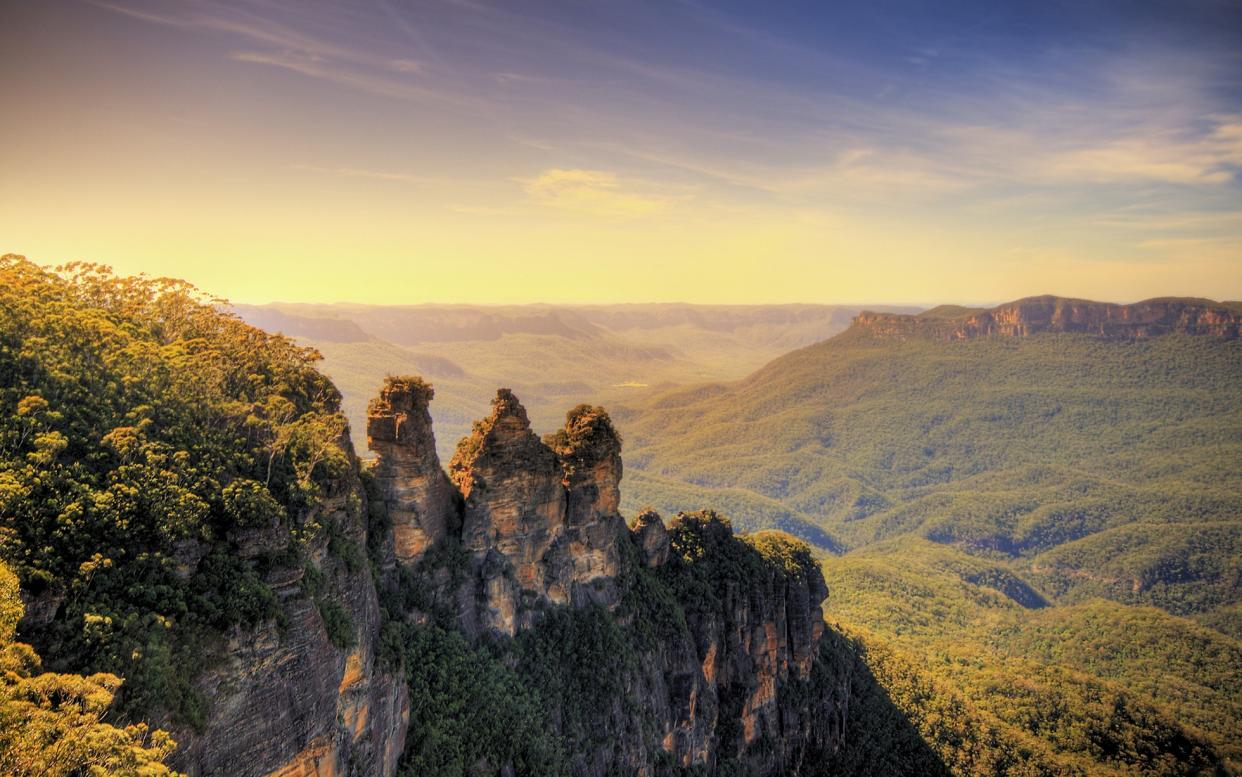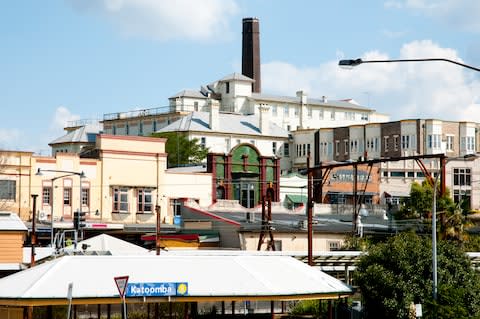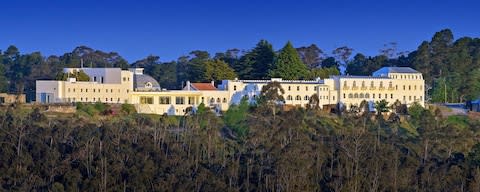The dark side of the Blue Mountains

A two-hour drive from Sydney, the Blue Mountains is a rugged Unesco-listed region covering 4,400 square miles, dotted with waterfalls and picturesque villages, and home to dramatic limestone cliffs and all manner of wildlife. The name comes from its distinctive blue haze – the result of eucalyptus oils from the forests mingling with water vapour and dust particles.
The traditional owners of the land, the Gundungurra and Darug peoples, have inhabited the region for the past 22,000 years. The area is home to Australia’s largest network of walking tracks, the world’s steepest funicular railway, and The Three Sisters, a unique sandstone formation. The rocks are named Meehni, Wimlah and Gunnedoo and, according to Dreamtime legend, were named after three sisters from the Katoomba tribe who fell in love with three brothers from the neighbouring Nepean tribe. Tribal law forbade them from marrying and a war ensued. An elder turned the sisters to stone for their own protection, but died before he could reverse the spell.
Katoomba, or as the locals call it, K-town, is the Blue Mountains’ largest village. Tourists clog the streets clutching cameras, while the locals include hip young families, wealthy intellectuals, artists and writers, many of whom have ditched the congestion and noise of nearby Sydney in favour of a slower lifestyle among the trees. It’s all very idyllic, the stuff of travel brochures. But scratch the surface a little and you’ll find some rather darker stories that make these mountains seems a lot more Twin Peaks and a little less Moominvalley.

The last cafe on Katoomba’s Art Deco main strip is The Yellow Deli. There’s a homely wooden interior and a bearded hipster in a flannel shirt behind the counter. So far, so normal. But then there are the words painted on the wall. “Eternity is a very, very long time” does seem a trifle... ominous. What your average Blue Mountains visitor might not be aware of is that the cafe is run by The Twelve Tribes community, described by many as a “cult”.
Founded in 1972 in Chattanooga, Tennessee, by Eugene Spriggs, a former carnival showman and guidance counsellor, The Twelve Tribes practices a hybrid of Judaism and Christianity and has been likened to the Amish for its rejection of modern technology. It preaches an ethos of love and togetherness and now has more than 3,000 members worldwide. There’s lots of dancing and tambourines. But it has been dogged by controversy and faced global criticism for its views on race, homosexuality and the strict discipline of children. In 2013 a police raided a Twelve Tribes community in Germany after collecting “evidence pointing to significant and ongoing child abuse by the members”.
In all honesty, if I were walking in uninformed I’d be smitten. The space is enchanting, like Tinkerbell’s treehouse. And my sandwich - an onion roll with corned-beef and provolone - was terrific. A search for the hashtag #yellowdeli on Instagram (there are Yellow Delis, run by Twelve Tribes outposts, all around the world) reveals that many share the same sentiment. “Does going against my morals for a tasty sandwich make me a bad person?” asks one visitor to the Yellow Deli in Nelson, British Columbia. A Vice reporter describes Katoomba’s outlet as “the cafe that’s so good people ignore it’s run by a cult”.
A post shared by yujin_seo�� (@you_genie_me89) on Dec 31, 2018 at 9:14pm PST
There’s another curio in the Blue Mountains. Just five miles up the road from Katoomba is Medlow Bath, home to The Hydro Majestic, a sprawling hotel with a colourful past. The eccentric jumble of buildings occupies a prime position overlooking the magnificent expanse of The Megalong Valley and has ownership of 12 miles of walking tracks. It’s also said to be haunted.
“We had a mystic come through the property before we reopened,” says front office manager Meagan Iervesi – referring to a $35m overhaul in 2014 – “to tell us if she sensed any spirits here. I cannot say much more… only to encourage everyone to visit this unique and wondrous property.” If you do stay, you might be lucky enough to see a rather distinguished former guest, Australia’s first prime minister, Sir Edmund Barton. He died in 1920 in the Belgravia Wing.

When Sir Arthur Conan Doyle stayed at the hotel in 1921 he described the property as “an Arabian Nights palace” and was said to have conducted seances. Staff members and hotel guests have reported seeing ghosts. Some think it due to the hotel’s time as a hospital for wounded American soldiers during the Second World War.
A grainy black-and-white photograph in one of the hallways reveals two apparitions hovering at the end of Cats Alley, the wing of the property where women were once relegated to sit and, apparently, gossip, while the men played billiards in the red-walled Salon du The. Both spaces have been restored impeccably and are now fine places to dine and drink, or enjoy a mystic High Tea Reading. “Learn the art of swirling your cup and letting the tea leaves settle or have your tarot cards read and discover what a day may bring forth,” says the website.
When you tire of the spirits and the “cults”, the Blue Mountains has misty, kangaroo-inhabited eucalyptus forests, sophisticated dining spots in Leura and Blackheath, antique bookstores, traditional tea rooms, and, of course, Meehni, Wimlah and Gunnedoo, still trapped in stone, overlooking it all. If those girls could talk.
Getting there
For packages to the Blue Mountains, try Trailfinders (020 7084 6500; trailfinders.com).
Staying there
The Hydro Majestic has rooms from £109 per night.
Local culture
An Aboriginal Blue Mountains Walkabout Tour costs from £55 (bluemountainswalkabout.com).

